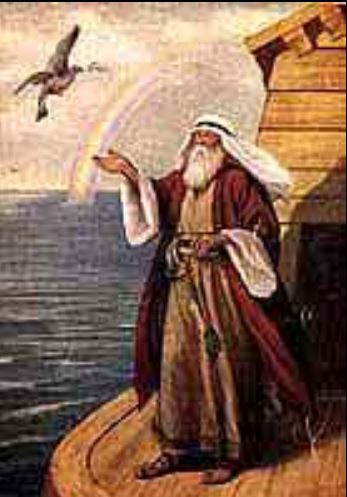Leading to John H’s long suit there, David. I wonder what the Kriol Bible says. g
From: Dr David Rosalky <>
Sent: Monday, 13 August 2018 6:30 PM
To: 'Geoffrey Dabb' <>;
Subject: RE: [canberrabirds] Avian drama in backyard
The picture reminds me of a posting I made some years ago about doves and the Bible.
The Jewish Bible has two different words for what are translated as “dove” (as was Noah’s twig-finder) and “turtle-dove”. Indeed,
the English translation of Song of Songs drops “dove” and refers to a “turtle” which conjures interesting images.
The Hebrew word for “turtle-dove” is pronounced “tor”. According to the various lexicons, it seems to have no apparent etymological
root, but is described rather as being onomatopoeic (at least according to the Brown, Driver, Briggs lexicon). So the bird presumably made a sound like “tor” or “tor-tor”. Hence, through a Middle East version of Chinese whispers, the word “turtle” emerged.
The interesting question from an ornithological nomenclature perspective is why doves and turtle doves have different names in a book
thousands of years old and still do in many references today. Is it purely that they make a different sound from other doves? Or are there other biological differences?
David R
From: Geoffrey Dabb
Sent: Monday, 13 August 2018 4:27 PM
To:
Subject: FW: [canberrabirds] Avian drama in backyard
 m("01D43329.4542ABE0","image001.jpg");">
m("01D43329.4542ABE0","image001.jpg");">
For what it is worth, I have seen the book
“Red-Tails In Love” at various bookshops over the years, and have a bit of an idea what it is about, but that is a big stretch to relate
it to John’s story, even given the use of those 2 words...... I would put Martha, the last Passenger Pigeon, who died in Cincinatti zoo, as more famous, and the three pigeons, serving with the Royal
Air Force, all of whom contributed to the recovery of air crew from ditched aircraft during the Second World War and who were in December 1943 the first recipients of the
PDSA Dickin Medal award. And many others with similar stories.
See the list at: https://en.wikipedia.org/wiki/Dickin_Medal
Philip
From: John Layton [m("bigpond.com","johnlayton2");">]
Sent: Monday, 13 August, 2018 3:16 PM To: 'Martin' Cc: 'Canberra birds'
Subject: RE: [canberrabirds] Avian drama in backyard
The book about Pale Male and family is “Red-Tails In Love” by Marie Winn. I can’t see it in the ACT Library Service catalogue, probably not surprising as it was published nearly 20 years ago.
John Layton
From: Martin [m("gmail.com","martinflab");">]
Sent: Monday, 13 August 2018 2:32 PM
To: Philip Veerman Cc: John Layton; Canberra birds
Subject: Re: [canberrabirds] Avian drama in backyard
Pale Male (capitalised) is possibly the most famous bird in the world. It is one of a pair that nest on 5th Ave in NYC and became famous when the owners of the building tried to destroy the nest. A number of
famous people (Mary Tyler Moore being one) joined the (successful) fight to save the birds. I would be surprised if the book about is not available in the ACT Library service.
On 13 Aug 2018, at 13:22, Philip Veerman <> wrote:
Huh? .........
Red-tailed Hawk is a North American bird. Actually a species of Buzzard.......... how does that enter the story?
Glissading?
Now that is a new one on me but seems correct.
From: Martin Butterfield [m("gmail.com","martinflab");">]
Sent: Monday, 13 August, 2018 11:18 AM
To: John Layton Cc: Canberra birds
Subject: Re: [canberrabirds] Avian drama in backyard
Tsk tsk John. You are surely aware that the (capitalised) Pale Male is a Red-tailed Hawk. A pale male Collared Sparrowhawk would barely form an hors-d'ouevre for him!
On 13 August 2018 at 10:56, John Layton <> wrote:
The stage was set and the cast in place but I missed most of the lead up and climax catching only the denouement. Happened like this, at 10:00AM yesterday I noticed a yellow Budgerigar
perched on power cables presenting a conspicuous target for a hungry raptor. Speaking of which I walked past one only noticing it when back on the porch and generally perusing the scene. It was then I saw a male Collared Sparrowhawk perched on a fence where
there’s a break in the neighbour’s Great Wall of Photinia. As is often the case with male Collared Sparrowhawks I marvelled at its smallness and remarkably pale plumage – Pale Male personified.
I needed to go indoors returning 15 minutes later but was unable to locate the hawk or the budgerigar until I noticed a stream of feathers glissading from atop a tall Silver Birch. And yes, they were yellow. Some 60 seconds later the sparrowhawk took off carrying
its prey into a large gumtree 50 metres away.
John Layton
Holt.

